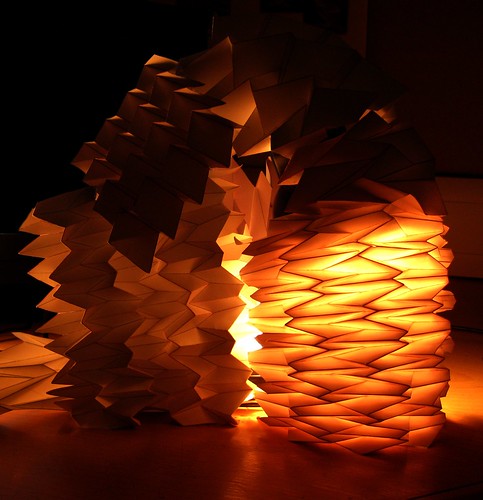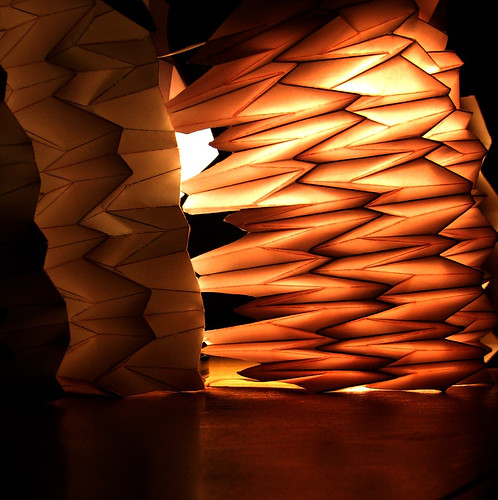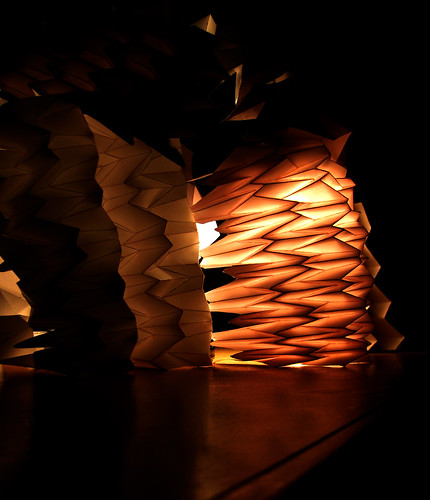Pooya Sareh: Origami Structure 1
Image by Engineering at Cambridge
Origami - the traditional Japanese art of paper folding - has been an interesting and inspiring subject that mathematicians have studied from the mid 1960's up to the present time. The most well-known engineering application of origami's folding rules has been the design of the so-called "Miura-ori". It was invented by Professor Koryo Miura from the Institute of Space and Aeronautical Science at Tokyo University, and was used in the design and simulation of the solar panel arrays for the Japanese space satellites in 1995. The "Miura-ori" is a 'Flat-foldable' pattern. Flat-foldable patterns reconfigure to flat surfaces in their completely folded conditions. To have practical and efficient deployable structures, designers usually attempt to minimize the volume of the structure in its folded condition. In the design of foldable shell or plate structures, this goal is theoretically achieved by decreasing the dimensions of the structures from 3D to 2D. We study generalized versions of the Miura pattern, and have developed a family of 'Flat-foldable' structures which can be used as conceptual designs for future engineering structures and products. Apart from their potential engineering applications, these structures can be presented as artistic products. The photographs of the paper models have been taken using the light emitted from a desk lamp which depicts the three dimensional form of the structures beautifully.
Pooya Sareh: Origami Structure 6
Image by Engineering at Cambridge
Origami - the traditional Japanese art of paper folding - has been an interesting and inspiring subject that mathematicians have studied from the mid 1960's up to the present time. The most well-known engineering application of origami's folding rules has been the design of the so-called "Miura-ori". It was invented by Professor Koryo Miura from the Institute of Space and Aeronautical Science at Tokyo University, and was used in the design and simulation of the solar panel arrays for the Japanese space satellites in 1995. The "Miura-ori" is a 'Flat-foldable' pattern. Flat-foldable patterns reconfigure to flat surfaces in their completely folded conditions. To have practical and efficient deployable structures, designers usually attempt to minimize the volume of the structure in its folded condition. In the design of foldable shell or plate structures, this goal is theoretically achieved by decreasing the dimensions of the structures from 3D to 2D. We study generalized versions of the Miura pattern, and have developed a family of 'Flat-foldable' structures which can be used as conceptual designs for future engineering structures and products. Apart from their potential engineering applications, these structures can be presented as artistic products. The photographs of the paper models have been taken using the light emitted from a desk lamp which depicts the three dimensional form of the structures beautifully.
Pooya Sareh: Origami Structure 4
Image by Engineering at Cambridge
Origami - the traditional Japanese art of paper folding - has been an interesting and inspiring subject that mathematicians have studied from the mid 1960's up to the present time. The most well-known engineering application of origami's folding rules has been the design of the so-called "Miura-ori". It was invented by Professor Koryo Miura from the Institute of Space and Aeronautical Science at Tokyo University, and was used in the design and simulation of the solar panel arrays for the Japanese space satellites in 1995. The "Miura-ori" is a 'Flat-foldable' pattern. Flat-foldable patterns reconfigure to flat surfaces in their completely folded conditions. To have practical and efficient deployable structures, designers usually attempt to minimize the volume of the structure in its folded condition. In the design of foldable shell or plate structures, this goal is theoretically achieved by decreasing the dimensions of the structures from 3D to 2D. We study generalized versions of the Miura pattern, and have developed a family of 'Flat-foldable' structures which can be used as conceptual designs for future engineering structures and products. Apart from their potential engineering applications, these structures can be presented as artistic products. The photographs of the paper models have been taken using the light emitted from a desk lamp which depicts the three dimensional form of the structures beautifully.
Pooya Sareh: Origami Structure 2
Image by Engineering at Cambridge
Origami - the traditional Japanese art of paper folding - has been an interesting and inspiring subject that mathematicians have studied from the mid 1960's up to the present time. The most well-known engineering application of origami's folding rules has been the design of the so-called "Miura-ori". It was invented by Professor Koryo Miura from the Institute of Space and Aeronautical Science at Tokyo University, and was used in the design and simulation of the solar panel arrays for the Japanese space satellites in 1995. The "Miura-ori" is a 'Flat-foldable' pattern. Flat-foldable patterns reconfigure to flat surfaces in their completely folded conditions. To have practical and efficient deployable structures, designers usually attempt to minimize the volume of the structure in its folded condition. In the design of foldable shell or plate structures, this goal is theoretically achieved by decreasing the dimensions of the structures from 3D to 2D. We study generalized versions of the Miura pattern, and have developed a family of 'Flat-foldable' structures which can be used as conceptual designs for future engineering structures and products. Apart from their potential engineering applications, these structures can be presented as artistic products. The photographs of the paper models have been taken using the light emitted from a desk lamp which depicts the three dimensional form of the structures beautifully.
Pooya Sareh: Origami Structure 5
Image by Engineering at Cambridge
Origami - the traditional Japanese art of paper folding - has been an interesting and inspiring subject that mathematicians have studied from the mid 1960's up to the present time. The most well-known engineering application of origami's folding rules has been the design of the so-called "Miura-ori". It was invented by Professor Koryo Miura from the Institute of Space and Aeronautical Science at Tokyo University, and was used in the design and simulation of the solar panel arrays for the Japanese space satellites in 1995. The "Miura-ori" is a 'Flat-foldable' pattern. Flat-foldable patterns reconfigure to flat surfaces in their completely folded conditions. To have practical and efficient deployable structures, designers usually attempt to minimize the volume of the structure in its folded condition. In the design of foldable shell or plate structures, this goal is theoretically achieved by decreasing the dimensions of the structures from 3D to 2D. We study generalized versions of the Miura pattern, and have developed a family of 'Flat-foldable' structures which can be used as conceptual designs for future engineering structures and products. Apart from their potential engineering applications, these structures can be presented as artistic products. The photographs of the paper models have been taken using the light emitted from a desk lamp which depicts the three dimensional form of the structures beautifully.
No comments:
Post a Comment